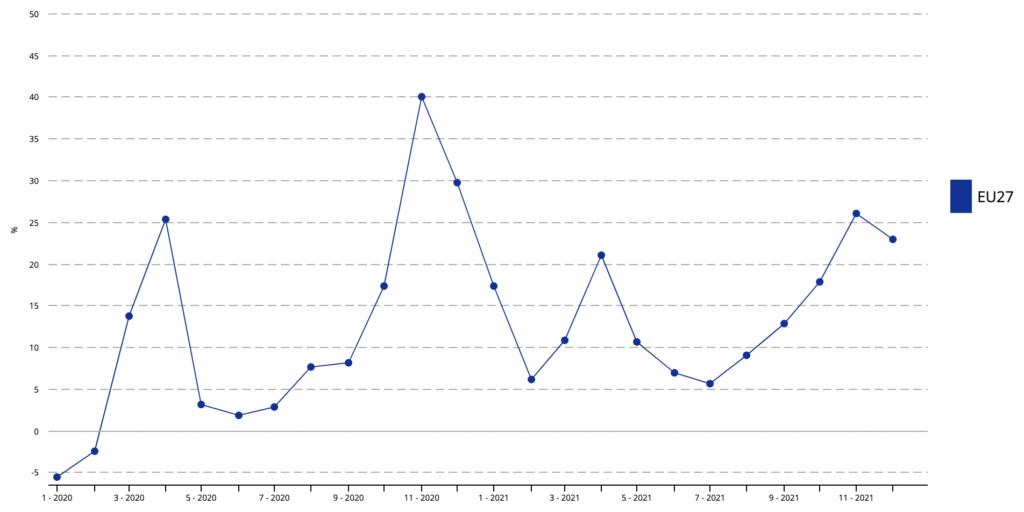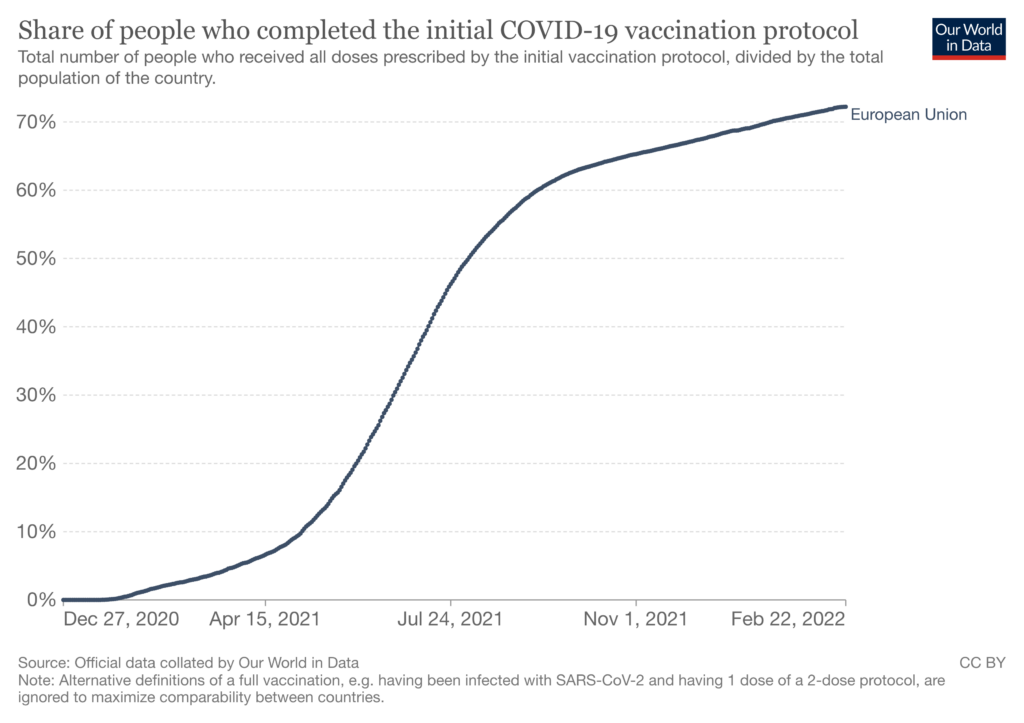One piece of evidence that vaccine effectiveness against death has been overestimated is that some countries’ post-vaccination waves were as or more deadly than their pre-vaccination waves – when going by excess mortality. These countries include Israel, Austria, Germany, the Netherlands and Norway.
Take Israel, for example. Despite having gone through two previous waves of Covid, and having double-vaccinated 55% of its population, the country saw a major third wave in the autumn of 2021. During this wave, excess mortality was higher than it had been in the winter of 2020-21.
Israel then saw another wave of Covid in January of 2022, during which excess mortality again peaked at higher level than it had done last winter. And this was after the country had begun rolling out fourth doses. It’s hard to reconcile the overall pattern with claims of, say, 90% effectiveness against death.
But perhaps I’m cherry-picking. What if the patterns of excess mortality in the five countries mentioned above are explained by some as-of-yet unknown idiosyncratic factors (as opposed to lower-than-claimed vaccine effectiveness)?
It’s hard to imagine what those idiosyncratic factors might be. What’s more, the five countries have something in common – they all experienced below-average excess deaths in their pre-vaccination waves. As a result, there may have been more very frail elderly people alive when their post-vaccination waves hit.
Another way to adress the charge of cherry-picking is to zoom out, and look at data for a larger grouping. Here’s monthly excess mortality for the EU-27 as a whole. (Four years of data from 2016-2019 were used to calculate the baseline, rather than the usual five.)

A similar pattern is evident. The peak of excess mortality reached in November of 2021 was actually higher than the peak reached in April of 2020 – when the pandemic first hit. Note that by August of 2021, fully 50% of EU citizens had been double-vaccinated (including a much higher percentage of the elderly).

If the vaccines are 90% effective against death, how do you explain the fact that excess mortality was greater in the autumn of 2021 (after not only a massive vaccination program but three previous waves) than it had been in the spring of 2020 (when the population was immunologically naïve)?
Once again: I’m not claiming that vaccine effectiveness against death is zero or even close to that. But I’ll remain sceptical of the 90% figure until someone can show that it’s consistent with excess mortality in Europe and Israel.
However, it should be noted that some countries’ data are consistent with very high vaccine effectiveness against death.
For example, Australia has not had more than five consecutive weeks of excess mortality since the pandemic began. On the other hand, the country’s data only go up to November of last year – so there may have been an as-of-yet unreported uptick corresponding to the recent summer wave of Omicron deaths.
Another puzzling country is Iceland, which managed to contain the virus up until December – when a major outbreak began. That outbreak is still ongoing, and the infection rate is now more than double the highest infection rate ever logged in Britain.
If vaccine effectiveness is much less than 90%, you’d expect to see a sharp rise in excess mortality in Iceland. Yet, so far, there has only been a slight uptick. On the other hand, if Omicron really is intrinsically milder, even very high infection rates will not translate into high levels of excess mortality.
It’s not yet clear to me why countries like Israel and Austria have seen deadly post-vaccination waves whereas others like Australia and Iceland have not. Perhaps we just need to wait for more data.











To join in with the discussion please make a donation to The Daily Sceptic.
Profanity and abuse will be removed and may lead to a permanent ban.
Is there any question about Omicron being milder than previous variants?
No. Had it 3 weeks ago. Its all classic cold symptoms, and mild ones at that. For me anyway. Mrs was worse but she’d had another cold just before and was run down. Yet we are still in an ’emergency’ situation that requires kids to be vaxxed.
I only realised I had actually ‘had it’ on my second consecutive+ testing.
The first time (tesed as routine for an unrelated blood procedure) I was a bit tired which was put down to a pre-existing condition which I still have and I’m still tired despite now being Covid Negative.
How are you now, KV? I always worry when you disappear for a few days as you did last week.
Sent a PM 11/3/22 telling all is well and apologies for missing your question.
Check this Bayer chap out, he doesn’t give a monkey’s toss about admitting his company conned people into getting injected with experimental gene therapies. By doing that Bayer has committed serious crimes.
It’s their brazenness in the face of these atrocious crimes that alarms me. Are they simply nuts, or are they cock-sure they will be protected from being served justice?
Did the execs at these companies take their muc? Did they let their families take it either?
Not likely. Would a farmer inject his children with the same veterinary medicines he’d dose his cattle with?
No chance. The “merits” of their Frankengoo is that it’s cheap to mass produce. It’s swill for the masses, not the masters.
No doubt in his world view the new gene therapy mass roll outs have been a fantastic success, telling a few porky pies to the untermenschen in order to allay fears and encourage widespread uptake, in the jaws of a global pandemic, was not only morally justifiable but essential to save mankind.
No, they have been exempted from any future criminal proceedings, so why would they give an S.H.1. T?
He’ll simply argue the toss about the meaning of “gene therapy”, like Fauci changing what “gain of function” means square in the middle of being caught engaging in it.
surely the difference is the strain of virus.
early days it is claimed those strains where more deadly, omicron is said to be like catching a common cold.
“It is claimed ” not by any source still credible to anyone with even the slightest evidence of intelligence.
quite possibly local genetics also
Edinburgh University scientists find 16 ‘Covid genes’ that raise your risk of falling critically ill | Daily Mail Online
Doesn’t Pfizer’s own documents prove the 95% claim was/is BS?
That’s relative don’t forget, not absolute.
In reality they managed to kill more healthy people they stuck than healthy people in the placebo group fgs.
Yes ! Pfizer still desperately fighting to holding back the full extent of their lies and rule breaking procedures !
Time to worry about the coming consequences of the mass experimental injections …not the scamdemic and the virus.
Mark Steyn called it out on GB News tonight – – the wall of vax damage silence is finally showing cracks!
Yup only him and Neil Oliver talks about it.
Our healthcare system is about to experience a tsunami! Potential side effects of jabs include chronic inflammation, because the vaccine continuously stimulates the immune system to produce antibodies. Other concerns include the possible integration of plasmid DNA into the body’s host genome, resulting in mutations, problems with DNA replication, triggering of autoimmune responses, and activation of cancer-causing genes. Alternative COVID cures EXIST. Ivermectin is one of them. While Ivermectin is very effective curing COVID symptoms, it has also been shown to eliminate certain cancers. Do not get the poison jab. If you want to get Ivermectin you can visit https://ivmpharmacy.com
“Vaccine effectiveness has been overestimated”
Are we surprised?
Given the limited effectiveness of any previously implemented vaccines against respiratory viruses, not in the least.
Dear old Noah still chasing the modeller’s construct of ‘excess mortality’ instead of real contextual data.
Please develop your argument for the benefit of the less well informed amongst us.
What’s more real than death?
[UPDATE] Oh! Eco-taxes.
Makes one wonder about genetic influences from what in some cases must be a very confined population
Another 10 genes now identified added to 6 previously known
Edinburgh University scientists find 16 ‘Covid genes’ that raise your risk of falling critically ill | Daily Mail Online
Perhaps excess death isn’t being driven by Covid. Perhaps it is being driven by break down of society by the public health authorities and their idiotic rules in regards to controlling Covid. Perhaps the original title of this website, “lockdownskeptic”, is a more useful focus than the culture war over vaccines.
Culture war? The lockdown crime was just a warm-up for the vaccine crime. Guilting, scaring and threatening the whole population into taking experimental drugs of questionable efficacy and safety profile. Implementing medical apartheid and dividing friends and families with propaganda.
I don’t know that my anger will ever subside.
Our underlying health status and socio-economic status influence our brush with Covid & Co more than our ‘vaccine status’, so re. Australia it might be interesting to see what vitamin D levels are like in the general population (my hunch:high) and re. Iceland I would surmise that there is less “shit-life syndrome” amongst the deprived compared with eg the UK. These may be some of the patterns that explain why they have had less excess mortality rates…
Give it time…
I heard in BBC Five Live this morning they reported that CDC said side effects are very rare for Pfizer vaccine etc. They must’ve got a bit rattled with the release of the trial documents.
Didn’t cdc just say today no deaths post vaxx and no serious adverse events




